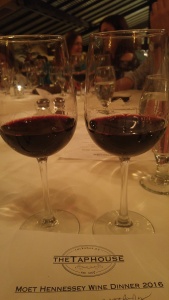Let’s be honest, it’s pretty easy to go out and spend $40 -$50 on a bottle of wine and feel confident that you are getting something that should be pretty damn tasty. I say ‘should be’ because believe it or not, there are plenty of disappointing wines at that price point. But more often than not, a wine of that price should possess some sort of quality in terms of region, grape selection, production and aging. But what is much harder is to find those $10-15 bottles that taste like something 2-3X the price… but they are out there my friends. Sometimes you have to stomach through a bunch of swill to find those great values, but like anything in life it takes a bit of determination and hard work to discover those hidden gems.

Check out this list of 15 wines, in no particular order, which have a tremendous QPR (Quality Price Ratio) and will run under $15. I am not including vintages as these wines are consistently solid just about every year and possess similar flavor profiles regardless of vintage (for the most part)… Cheers!
White/Rosé
Belle Ambiance Pinot Grigio, CA – This is like the house white wine for my block. A PG with some body to match up to the acidity, with pretty floral notes surrounding the citrus fruit center.
 Fox Run Dry Riesling, FLX – Keep it local with one of my favorite Finger Lakes value wines. A little like Sprite on the palate (lemon/lime with just a quick hit of pettilance) with fresh grapefruit and searing acidity, a home run pairing for any kind of chilled shellfish.
Fox Run Dry Riesling, FLX – Keep it local with one of my favorite Finger Lakes value wines. A little like Sprite on the palate (lemon/lime with just a quick hit of pettilance) with fresh grapefruit and searing acidity, a home run pairing for any kind of chilled shellfish.

Louis Jadot Chardonnay Bourgogne Blanc – Classic Burgundy entry level Chardonnay with a concise balance of crisp apple and pear fruit, bright acidity and just a hint of that buttery character.
NV House Wine Rosé Can – Good wine is coming in all shapes and sizes these days, so don’t let the can scare you! This is a great summer sipper, porch pounder…whatever you want to call it. Fresh and bright strawberry fruit with an appealing rose petal note.

Red
Vidal Fleury Cotes du Rhone – One of the biggest and most expressive CDRs at this price point. Concentrated red and black cherry fruit, peppery spice and mineral notes are all in balance as is the bright acidity and firm tannins. Easily could pass as a Gigondas for twice the price.

Cantele Salice Salentino Riserva – Made from 100% Negroamaro, the dominant grape in this area of Puglia, this has a fairly intense nose featuring dried fruit such as raisin, prune and fig. But the candied blackberry and cherry notes come through on the palate and flow through the dry, pleasing finish. Big yet balanced…

Purple Malbec Cahors – Chateau Lagrezette’s entry level red, this is simply a wonderful expression of Malbec from the motherland (France) with bright acidity, vibrant black fruits and just a dollop of black pepper.

Seaglass Pinot Noir, Santa Barbara – This is a perennial ‘best value’ Pinot for me as it stays light and lively on the palate but exudes true Pinot character, which most Pinots at this price point fail to do.
Underwood Pinot Noir, OR (Can) – Am I having this with a roasted duck? No… But for a light everyday wine this has enough fruit and depth to make it fully enjoyable. And do you know what doesn’t break and shatter all over the floor for your kids to step on and get little pieces of glass stuck in their feet?? Cans… that’s what.

 Slow Press Cabernet, CA – This has to be the best CA Cab for the Price on the market. All that Paso Robles fruit gives this full bodied wine an opulent core of black cherry, cassis and plum with just a kiss of sweetness. Plush and supple, but with enough depth to enjoy with a grilled steak.
Slow Press Cabernet, CA – This has to be the best CA Cab for the Price on the market. All that Paso Robles fruit gives this full bodied wine an opulent core of black cherry, cassis and plum with just a kiss of sweetness. Plush and supple, but with enough depth to enjoy with a grilled steak.

Rosso di Ca’Momi, CA – A fun blend of Cabernet Sauvignon, Zinfandel, Merlot and Petite Sirah. Medium to full bodied with a fairly intense nose of toasted vanilla, blackberry and clove. Super value at around $10.

Chateau Souverain Merlot, CA – Sorry Miles, but I am drinking THIS f&%king Merlot! It has some real umph to it with big dark fruit flavors, toasty oak laced with clove and spice aromas. Probably the best wine of the bunch here…
Lines of Wine
Columbia Crest Grand Estates, WA – While the Syrah is my favorite in the line, this value brand under Ste. Michelle Estates is continually awarded “Best Buy” accolades from top publications, and for good reason. Tough to find a bad one in the lineup.


Handcraft Wines, CA – The Delicato family produces this line of wines which offer tremendous value and drinkability across the board. Taste the Dark Red Blend and the Petite Sirah and you will understand exactly what I mean.
Bota Box – Boxed wine is not how you may remember it. This is no Franzia or Almaden, so get over the stigma already. Bota is producing really solid juice from all over the world (although mostly CA). And at $20 a 3L box (or $5 a bottle) there is no better value on the market, particular for the whites like Pinot Grigio, Sauvignon Blanc and Riesling.













